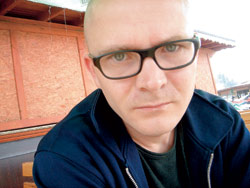Federica Cavallin made this model of Gerrit Rietveld’s 1919 Kinderstoel (Child or Baby Chair) as part of her study. Her sites has disappeared since publishing this post.
Category: famous chair
Hans Wegner Sawbench Chair
Photo thanks to Danish Furniture
I post this chair as a tribute to my father. This was one of his favorite chairs. You don’t need cushions for a comfortable seating. It kept you for hours uninterruptedly very comfortably, even when you are tall (I am 6’4, or 1.90 m). That is a sign of good design.
With his love of natural materials and his deep understanding of the need for furniture to be functional as well as beautiful, Hans J. Wegner (1914) made mid-century Danish design popular on an international scale. He began his career as a cabinetmaker in 1931 and subsequently entered the Copenhagen School of Arts & Crafts. After receiving his architectural degree in 1938, he worked as a designer in Arne Jacobsen and Erik Mølle’s architectural office before establishing his own office in 1943.
With more than 500 different chair designs Wegner is the most prolific Danish designer to date. His international breakthrough and greatest sales success came in 1949 when he designed the Round chair. The American magazine Interiors featured the chair on the cover and referred to it as the world’s most beautiful chair. The chair rose to stardom when used in the televised presidential debates between Nixon and Kennedy in 1960 and has since been known simply as The Chair.
The real beauty of Wegner’s genius must be seen in context with his collaboration with master cabinetmaker Johannes Hansen. The attitude with which Johannes Hansen accepted the young designe’s ideas was the perfect combination between designer and craftsman. Their collaboration went on for many years, and they presented their work at the Cabinetmaker’s show every year from 1941 – 1966.
Philippe Starck WW Stool
Philippe Starck WW Stool
In 1991 Philippe Starck designed a fantasy office environment for German film director Wim Wenders (look here for Wim Wenders’ official site). One element of this environment, the WW Stool, is now in production in small series by Vitra. The filigrain design is more a sculpture that it can be used as a stool. It may serve as support for users who prefer to stand rather than an item of furniture intended to be purely functional.
Material: varnished sand-cast aluminum.
Functionalfate.org – Jens Thiel’s Monobloc Plastic Chairs Weblog [Disappeared]

Photo thanks to Austrian Der Standart
Functionalfate.org – Jens Thiel’s Monobloc Plastic Chairs Weblog was a blog tat disappeared in the meantime. I noticed it already when I was playing with the idea of starting my own Blog devoted to Chairs. Jens is addicted to the monobloc plastic chair:
This ceramic edition is less sore for my eyes;-)
His credo is:
practical / inexpensive / ecological / lightweight / washable / warm / sturdy / clean / weatherproof / inconspicuous / comfortable / stackable / smooth / airy / contemporary / ubiquitous / pragmatic MONOBLOC PLASTIC CHAIRS
His aim is collecting plastic chairs and work on an extensive illustrated monograph (partly to be seen in an article of ArtReview), to establish a museum exhibition and a documentary feature about this most successful and most hated furniture of all human creation: the monobloc plastic chair. He warmly invites everybody to contribute photos, stories or even chairs.
Well Jens, contact me: I have some of those for you:-)
Coming to think of it: This much hated monobloc plastic chair could be an excellent attribute for the Little People A tiny street art project Blog.
Update: Functinal Fate has disappeared but I found a German alternative dedicated to the monoblock chair: PlastikStuhl. Moreover: Jens Thiel‘s Flickr account seems still in operation.
Rietveld’s Steltman Chair
Rietveld’s Steltman Chair
the chair he designed for the Steltman Jewelry Store
Photo thanks to Rietveld by Rietveld.
To conclude this short series on Rietveld chairs this extra ordinary design made for Steltman Jewelers established in The Hague since 1917.





